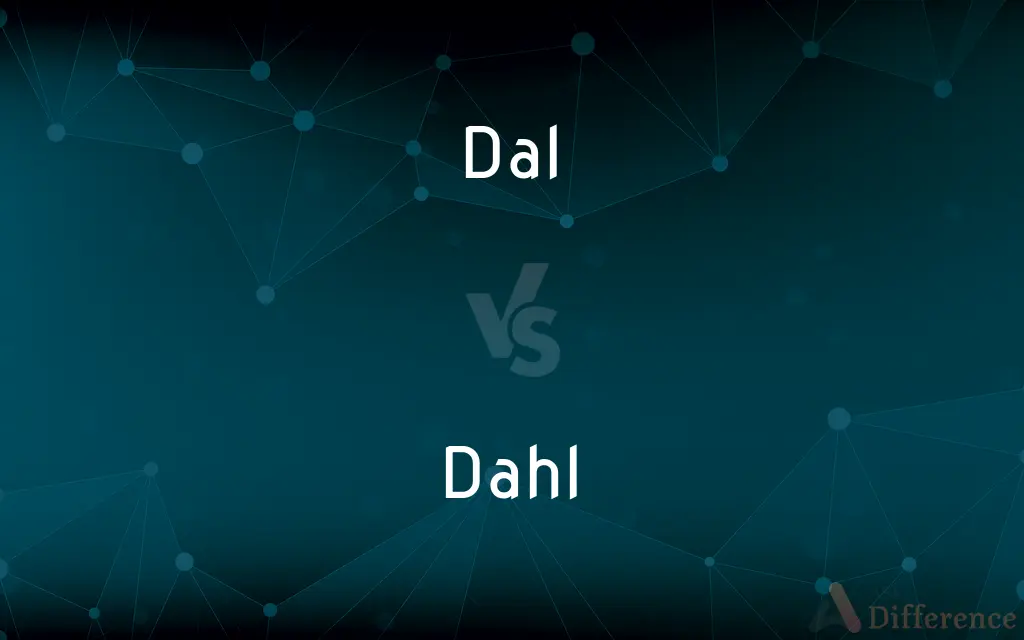Dal vs. Dahl — What's the Difference?
By Tayyaba Rehman & Urooj Arif — Updated on March 24, 2024
Dal refers to dried lentils, peas, or beans used in South Asian cuisine, while dahl is an alternate spelling, often reflecting pronunciation variations.

Difference Between Dal and Dahl
Table of Contents
ADVERTISEMENT
Key Differences
Dal is a term used in South Asian cuisine to refer to both dried lentils, peas, or beans and the dish prepared from these legumes, characterized by its spiced, often soupy consistency. Dahl, on the other hand, is an alternate spelling of dal, reflecting regional pronunciation differences or transliteration choices from languages using non-Latin scripts.
Both dal and dahl are integral to diets in South Asia, serving as a primary source of protein, especially in vegetarian diets. The spelling variation does not indicate any difference in the type of lentil or preparation method but rather linguistic preferences.
The preparation of dal (or dahl) varies widely across regions, with each area having its unique recipes, spices, and serving methods. Whether referred to as dal or dahl, these dishes are typically simmered until soft, then tempered with spices fried in ghee or oil, and often served with rice or bread.
In English-speaking countries, the spelling dal is more commonly used in cookbooks and restaurants. Dahl, while less common, appears in various contexts, including literary references, personal names, and menu items, reflecting the diverse English spelling conventions influenced by South Asian languages.
Nutritionally, both dal and dahl dishes are high in protein, fiber, and essential nutrients, contributing to their popularity as staple foods in South Asian cuisine. The choice between using "dal" or "dahl" is largely a matter of personal or regional preference and does not affect the culinary or nutritional aspects of the dish.
ADVERTISEMENT
Comparison Chart
Definition
Dried lentils, peas, or beans; also, a dish prepared from these legumes
Alternate spelling of dal, reflecting pronunciation variations
Usage
Commonly used in South Asian cuisine to refer to legumes and the dishes made from them
Same as dal, used interchangeably depending on linguistic preference
Regional Preference
Predominantly used spelling in cookbooks and culinary contexts
Used based on regional dialects, transliteration choices, or personal preference
Preparation
Involves simmering legumes and tempering with spices
Identical to dal, with variations in recipes across regions
Nutritional Value
High in protein, fiber, and essential nutrients
Identical nutritional value to dal
Compare with Definitions
Dal
Varieties include toor dal, masoor dal, and chana dal.
Masoor dal cooks quickly, making it perfect for a weeknight meal.
Dahl
Same nutritional benefits as dal, rich in proteins.
Adding dahl to your diet is a great way to increase protein intake.
Dal
A staple food in South Asian cuisine made from lentils.
For dinner, we had a comforting bowl of dal with rice.
Dahl
Used interchangeably with dal in recipes and cookbooks.
Her cookbook includes a recipe for red lentil dahl.
Dal
Refers to the dried legumes used in making the dish.
I bought several types of dal from the grocery store.
Dahl
An alternative spelling of dal used in some English-speaking regions.
The menu featured a spicy dahl as the vegetarian option.
Dal
Often seasoned with a variety of spices.
The dal was tempered with cumin and mustard seeds for extra flavor.
Dahl
Can be spelled differently based on personal or cultural preference.
Regardless of whether you call it dal or dahl, it's delicious.
Dal
Served with rice or bread as a main or side dish.
Roti and dal make a complete meal.
Dahl
Reflects pronunciation differences in various dialects.
He preferred the spelling dahl to match his regional dialect.
Dal
Dal (also spelled daal; pronunciation: [d̪aːl]) is a term originating in the South Asia for dried, split pulses (e.g., lentils, peas, and beans) that do not require soaking before cooking. Certain regions in Bangladesh and India are the largest producers of pulses in the world.
Dahl
Lentils, peas, or other legumes that have been dried, hulled, and split.
Dal
Variant of dahl.
Dahl
A thick South Asian stew made from such legumes with various seasonings.
Dal
Any of many dried husked pulses (legume), including peas, beans and lentils.
Dahl
Alternative spelling of dal
Dal
A dish made from lentils, cooked with spices, tomatoes and onions etc.
Dahl
Tropical woody herb with showy yellow flowers and flat pods; much cultivated in the tropics
Dal
A tropical herb with yellow flowers; the pigeon pea.
Dahl
Small highly nutritious seed of the tropical pigeon-pea plant
Dal
Split pulse, esp. of Cajanus Indicus.
Dal
A metric unit of volume or capacity equal to 10 liters
Common Curiosities
Is dal considered healthy?
Yes, dal is high in protein, fiber, and essential nutrients, making it a healthy addition to any diet.
How do I choose which lentils to use for making dal?
The choice depends on personal preference and the specific recipe being used; different lentils offer varying textures and cooking times.
Does the choice between dal and dahl affect cooking methods?
No, the choice of spelling does not affect the cooking methods or recipes used to prepare the dish.
Is there a difference between dal and dahl in terms of ingredients?
No, there's no difference in terms of ingredients; dal and dahl refer to the same lentils and dishes.
Are dal and dahl suitable for vegetarians and vegans?
Yes, both are staple foods in vegetarian and vegan diets, providing a significant source of plant-based protein.
Can dal (or dahl) be made with any type of lentil?
Yes, dal can be made with various types of lentils, peas, or beans, each offering distinct flavors and textures.
Can dal be frozen for later use?
Yes, dal freezes well and can be stored for future meals, maintaining its flavor and nutritional value.
Why are there different spellings for dal?
The different spellings reflect regional pronunciation variations and transliteration choices from non-Latin scripts.
How is dal typically served?
Dal is commonly served with rice or bread (such as roti or naan) and can be accompanied by vegetables or meat dishes.
Is dal (or dahl) easy to make?
Yes, dal is generally straightforward to prepare, making it a popular choice for both everyday meals and special occasions.
Share Your Discovery

Previous Comparison
Grew vs. Grow
Next Comparison
Nazism vs. FascismAuthor Spotlight
Written by
Tayyaba RehmanTayyaba Rehman is a distinguished writer, currently serving as a primary contributor to askdifference.com. As a researcher in semantics and etymology, Tayyaba's passion for the complexity of languages and their distinctions has found a perfect home on the platform. Tayyaba delves into the intricacies of language, distinguishing between commonly confused words and phrases, thereby providing clarity for readers worldwide.
Co-written by
Urooj ArifUrooj is a skilled content writer at Ask Difference, known for her exceptional ability to simplify complex topics into engaging and informative content. With a passion for research and a flair for clear, concise writing, she consistently delivers articles that resonate with our diverse audience.














































